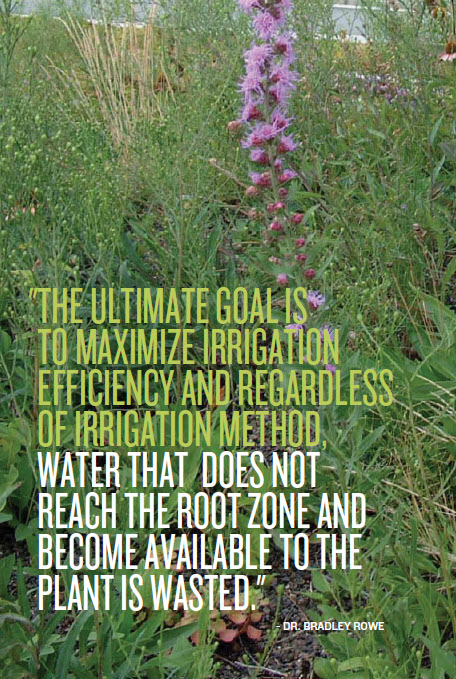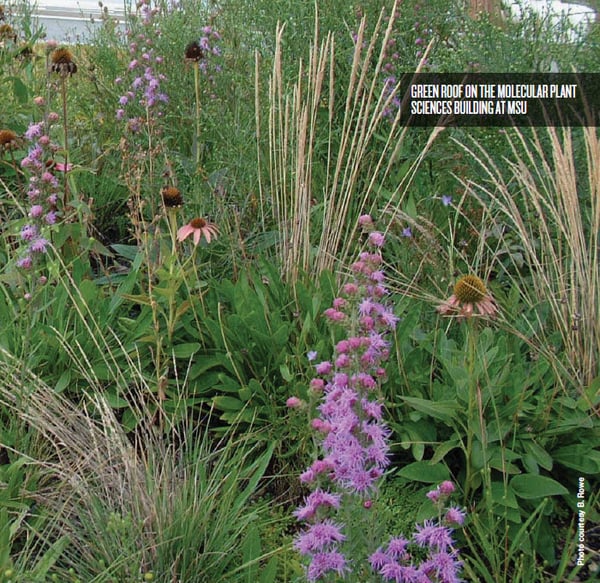The ability of a green roof to retain stormwater depends on many factors including plant species, substrate depth and composition, and the preexisting moisture present before a given rain event. All of these factors can be influenced by irrigation practices which in turn may have a positive or negative influence on a green roofs ability to retain stormwater.

Plant species can influence stormwater retention. Plant photosynthetic metabolism has a major effect on transpiration (see Living Architecture Monitor 18(1):24-29). In addition, those plants with more biomass have a greater ability to intercept rainwater with their foliage and allow it to evaporate before reaching the substrate surface. Nagase and Dunnett (2012, Landscape and Urban Planning 104:356-363) showed that plant types such as forbs and grasses that possessed greater shoot and root biomass were more effective in reducing water runoff than those with less biomass such as sedum.
Tied to plant species is substrate depth and composition. Deeper substrates are able to hold more water and therefore are able to support plants with greater biomass. Changes in composition can also influence water holding capacity and capillary movement. As aerated pore space decreases, water holding capacity increases and vice versa.
In addition, pre-existing substrate moisture present before a given rain event is a major factor. To achieve maximum
stormwater retention we want the roof to be dried out before each rain event. However, a minimum moisture level must be maintained if one wishes to keep alive the herbaceous perennials and grasses that possess this greater biomass. Because of their higher transpiration rates many of these plants may die during periods of drought. In addition, in some cases a shallower depth supporting sedum may actually be able to hold more rainwater since this shallow depth may be completely dry, whereas a deeper depth may still contain pre-existing moisture.
A good example is the roof on the Molecular Plant Sciences Building at Michigan State University. This roof was planted in a substrate depth of 20 cm (8 in) with 17 species of native herbaceous perennials and grasses during 2011. The roof was watered as needed the first two years to ensure establishment, but thereafter it had to rely on natural rainfall. After eight years, ten of the original 17 species have disappeared. The roof is now dominated by Allium cernuum with a limited number of Asclepias tuberosa, Coreopsis lanceolata, Geum triflorum, Koeleria
macrantha, Penstemon hirsutus and Sporobolus heterolepis still present. There is also sedum infiltrating from the surrounding shallower roof. Plant diversity decreased every year, but plummeted in 2016. The major die off was likely due to drought conditions during the spring and summer of 2016. During a 57 day period, May 16 to July 11, total rainfall amounted to 3.28 cm (1.29 in). About a third of that fell on one day, July 1. Comparatively, normal rainfall for May, June, and July is 8.5, 8.8, and 7.2 cm (3.35, 3.46, and 2.83 in), respectively.
 The Molecular Plant Sciences study points out the fact that supplemental irrigation may be critical to maintaining species diversity on a green roof. Irrigation may be necessary or the substrate must be deep enough to support the plants selected. Apparently, 20 cm (8 in) is not deep enough for long-term survival of herbaceous perennials and grasses in East Lansing, Michigan. Overall, a balance must be found between providing enough water to maintain plant health and aesthetics while allowing the substrate to dry out enough to provide maximum stormwater storage capacity. To increase water use efficiency, moisture sensors could be installed in the substrate that would trigger an irrigation event when water availability reaches a minimum threshold.
The Molecular Plant Sciences study points out the fact that supplemental irrigation may be critical to maintaining species diversity on a green roof. Irrigation may be necessary or the substrate must be deep enough to support the plants selected. Apparently, 20 cm (8 in) is not deep enough for long-term survival of herbaceous perennials and grasses in East Lansing, Michigan. Overall, a balance must be found between providing enough water to maintain plant health and aesthetics while allowing the substrate to dry out enough to provide maximum stormwater storage capacity. To increase water use efficiency, moisture sensors could be installed in the substrate that would trigger an irrigation event when water availability reaches a minimum threshold.
If the decision is made to provide irrigation, the next question is by what method. When comparing the efficiency of overhead, drip, and subirrigation on green roofs, we found that overhead was most favorable for water distribution and retention as well as plant health (Rowe et al., 2014, Ecological Engineering 64:306-313). Because green roof substrates tend to be coarse to allow adequate drainage, limited capillary movement resulted in the majority of the water draining directly to the bottom and out of the system for both the drip and sub-irrigation treatments. In contrast, overhead irrigation distributed water over 100 per cent of the surface, wetted the entire area in a much shorter period of time, and resulted in less wasted water. This conclusion could be altered depending on factors such as windy conditions, frequency and duration of irrigation events, spacing of emitters, and whether the roof was just planted or had time to become established. Even so, drip irrigation may be more practical for irrigating individual plants such as trees, shrubs, or vegetables that may be found on an intensive roof. The ultimate goal is to maximize irrigation efficiency and regardless of irrigation method, water that does not reach the root zone and become available to the plant is wasted.
In addition, the use of moisture retention fabric (MRF) and cups in drainage layers are other methods to retain additional water. In the above irrigation study comparing irrigation methods, the use of MRF improved irrigation efficiency for all three irrigation methods, especially for drip and sub-irrigation. In contrast, in a previous study we found no consistent differences in plant growth or visual appearance among systems with retention cups and those without retention cups (Monterusso et al., 2005, Hort- Science 40(2):391-396). However, the physical existence of such cups means that some volume of water is retained in them.
As green roof practitioners, the choices we make in plant selection, substrate depth, and irrigation practices will go a long way in determining how well a green roof performs.
Brad Rowe has been conducting green roof research at MSU since 2000. Research topics include plant selection, growing substrates, carbon sequestration, stormwater runoff, energy conservation, and roof vegetable production. He was the founding chair of the GRHC Research Committee and received the GRHC Research Award of Excellence in 2008. Brad also teaches a course on green roofs and walls at MSU.
Source: 2018 Stormwater Issue of the Living Architecture Monitor Published by Green Roofs for Healthy Cities



